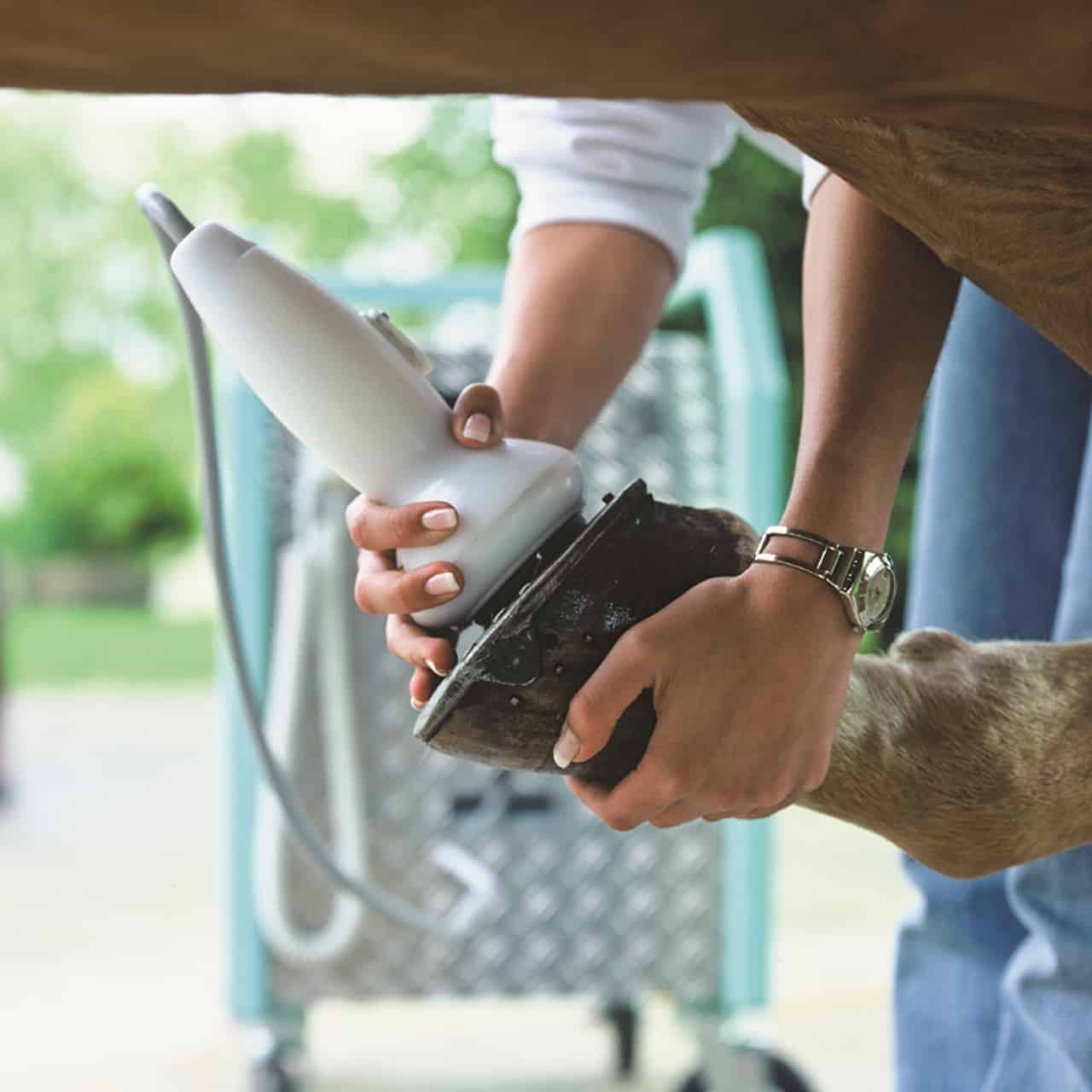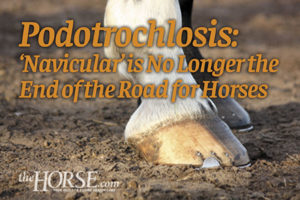Dealing with Navicular Disease

Navicular disease is a degenerative condition of the navicular bone and soft tissues in the back of the horse’s foot. Over the years veterinarians have referred to the condition by many names, but the current accepted vernacular is “caudal heel pain.” It can be devastating when your veterinarian reaches this diagnosis, but treatment options exist and many horses can return to athletic work.
When treating a horse with caudal heel pain, the simplest change to make involves his trimming and shoeing. The farrier’s goal should be to decrease the deep digital flexor tendon’s (DDFT) tension during movement as well as the pressure it applies over the navicular bone. Many horses benefit from the farrier shortening or squaring the toe to create an early point of breakover in the stride, which also decreases DDFT tension. Another tension-reducing technique, used in combination with an earlier breakover, is elevating the heel with a wedge or by establishing more heel wall. There are many shoes designed to treat caudal heel pain specifically. Because detailed care for these horses’ hooves is very important, ensure your veterinarian and farrier work together to find the best options for your horse.
The next avenue to explore is the use of non-steroidal anti-inflammatory drugs (NSAIDs) to modify the degree of foot discomfort. The standard NSAID veterinarians offer is phenylbutazone (Bute), which works well in mild to moderately affected horses. There are some side effects to chronic Bute use, however, including gastric ulcers. Firocoxib (Equioxx) is an anti-inflammatory drug that has been gaining popularity as it can provide similar anti-inflammatory/pain suppression qualities to Bute, but without the negative side effects. Other anti-inflammatories veterinarians use include flunixin meglumine (Banamine), ketoprofen (Anafen), meloxicam (Metacam), and others.
If the first-line treatment of therapeutic shoeing and anti-inflammatories fails, the next step your veterinarian might suggest is corticosteroid joint injections directly into the affected areas: the coffin joint and navicular bursa. The goal is to squelch the inflammation in the foot and provide a better degree of soundness for a period of time. A veterinarian might base his or her choice of navicular bursa versus coffin joint injection on preference, clinical signs, or a specific diagnosis. The steroids generally take about 10-14 days to produce noticeable improvement, and you can generally expect three to 12 months of soundness depending on disease severity.

There are many other medical treatments for caudal heel pain, including hyaluronic acid (HA), tiludronate (Tildren, not yet FDA-approved for use in the United States), and extracorporeal shock wave therapy. Hyaluronic acid is a joint medication veterinarians inject into the joint or administer intravenously (IV) to help decrease inflammation of the joint’s synovial lining. Tildren is a human osteoporosis medication that has gained popularity for use in horses with suspected navicular bone resorption lesions; the medication suppresses bone loss and is thought to decrease inflammation as a result. Practitioners administer it either IV or by regional perfusion into the foot. With shock wave therapy, clinicians aim to provide pain relief and improve tendon and ligament injury healing. Veterinarians apply it directly over the heels and coffin joint as necessary and conduct three to six treatments, two to three weeks apart.
Surgeons can treat horses with caudal heel pain using several approaches, the main one being neurectomy (severing the nerves supplying sensation to the back of the foot). This generally produces soundness in the foot; however, there are some drawbacks (e.g., DDFT rupture, neuroma, nerve regrowth) that make this option a salvage procedure reserved for when medical management fails. A neurectomy can provide pain relief and even return to athletic function, but generally only for a three- to five-year period.
Recent surgical advancements have expanded practitioners’ options for treating caudal heel pain: Surgical debridement of the abnormal adhesion between the navicular bone and the DDFT within the navicular bursa has shown some promise, as well as transection/cutting of particular ligaments of the navicular bone.
Written by:
Chris Bell, BSc, DVM, MVSc, Dipl. ACVS
Related Articles
Stay on top of the most recent Horse Health news with















